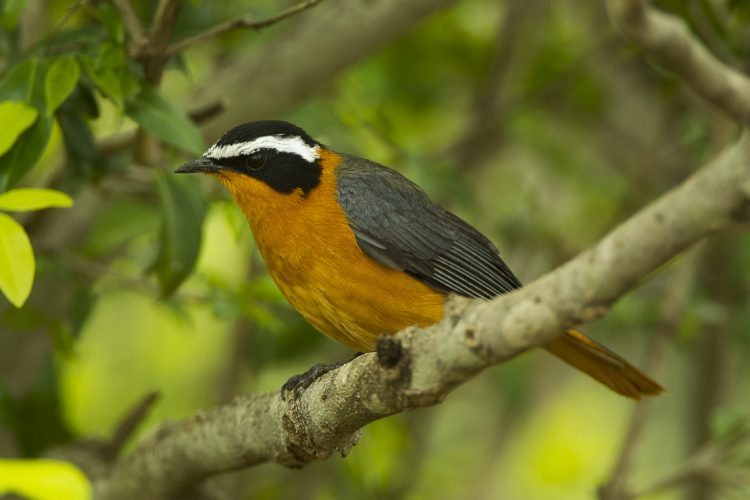Description
Heuglin’s Robin is the most wide-ranging Cossypha robin in the Afro tropical region but has only a limited distribution in the more tropical parts of southern Africa. The range extends from northern KwaZulu-Natal through Swaziland, the Transvaal Lowveld, and the Limpopo Valley, over most of Zimbabwe, and westward into the Okavango and Caprivi regions. Heuglin’s Robin is also known as the white-browed robin-chat, (Cossypha heuglini) it is a species of bird in the family Muscicapidae.
It is recognized two subspecies in southern Africa: C.h. orphea with a stronghold in the Okavango and adjacent tributaries to the Zambezi River, and euro note east of this throughout the remainder of the region. Its magnificent crescendo duetting song is one of the characteristic sounds of Africa in both towns and wildlife sanctuaries.
Its white eyebrow and overall bright orange under-parts provide a unique combination that should preclude confusion with any other southern African bird, yet for many years other species have repeatedly been misidentified as Heuglin’s Robin in areas that are ecologically unsuitable and outside its range.

Heuglin’s Robin Habitat:
Throughout its range, it is a characteristic species of riverine forest, even where this is limited to a thin discontinuous fringe. Where it is common it also frequents evergreen thickets (as on termite mounds) in woodland and in modified areas, frequenting the gardens of homesteads and towns.
In the Transvaal and Zimbabwe, it was found most commonly (up to 3 birds/ha) in the riverine forest with a high percentage of evergreens, discontinuous canopy, and well-developed shrub and ground layers. The vegetation analysis besides showing where it is most commonly encountered provides a diagrammatic representation of its decreasing abundance and smaller range from Zimbabwe southwards. From Zimbabwe northwards it is a common garden bird and may nest close to human dwellings in places such as vine-covered verandah trellises.
Heuglin’s Robin Vocalizations
The Heuglin’s Robin contact calls include repeated pit-porlee, chiiritter-porlii and da-da-da-teee and end with da-teeee or chickle-ter-tweep. Therefore, the alarm call is takaata-kaata-kaata. The white-browed robin-chat has a melodious song, usually given at dawn and dusk, which is quiet at first, and then becomes louder. It consists of many pip-pip-ureee, when singing loudly, its beak is wide open and its breast is inflated. The bird’s tail moves when each note is sung. Also, some observations have been seen when pairs may duet.
Movements:
It is not known to undertake regular seasonal movements anywhere within its range. The slightly lower reporting rates in winter in some regions are probably explained by quieter and more covert behavior in the nonbreeding season.
Breeding:
The bird records are showing that its breeding starts in July–May in the north and September–April further south (Zone6) with a general peak in October–November.
Eggs
Eggs are laying in usually restricted to September–January. But on a few observations have been recorded in August from Zimbabwe notwithstanding.
Diet
Heuglin’s Robin diet consists of many different things, like beetles, ants, termites, and some other insects, arthropods, frogs, and variable fruits. The robin likes to bathe in water.
Interspecific Relationships
From the eastern high lands of Zimbabwe south into the Transvaal and KwaZulu-Natal (and in many other parts of its Afrotropical range), it shares its habitat with the Natal Robin C. natalensis (Farkas1969). These species breed alongside each other and have similar diets but there is as yet no evidence of so-called competitive exclusion of either species by the other.
Historical Distribution and Conservation:
It appears to be slowly extending its established range in the south. In the 1950s its southernmost limit was that portion of the Mkuze River east of the Lebombo range (the ‘northern Zululand’ of McLachlan & Liversidge 1957). By 1970 the birds sit had reached the Hluhluwe River in the south and pushed west of the Lebombo range by way of the Pongolo and Mkuze rivers into the Louwsburg and Magut districts of KwaZulu-Natal.
However, severe damage is done to the riverine forests of northern KwaZulu-Natal by Cyclone Demoina in 1987, when it has probably halted or at least set back this expansionary phase. Heuglin’s Robin is common throughout most of its widespread Afro tropical range and is not listed The IUCN classifies it as a least-concern species.
Read More – Loggerhead Shrikes on Nesting Birds in a Sagebrush Environment







